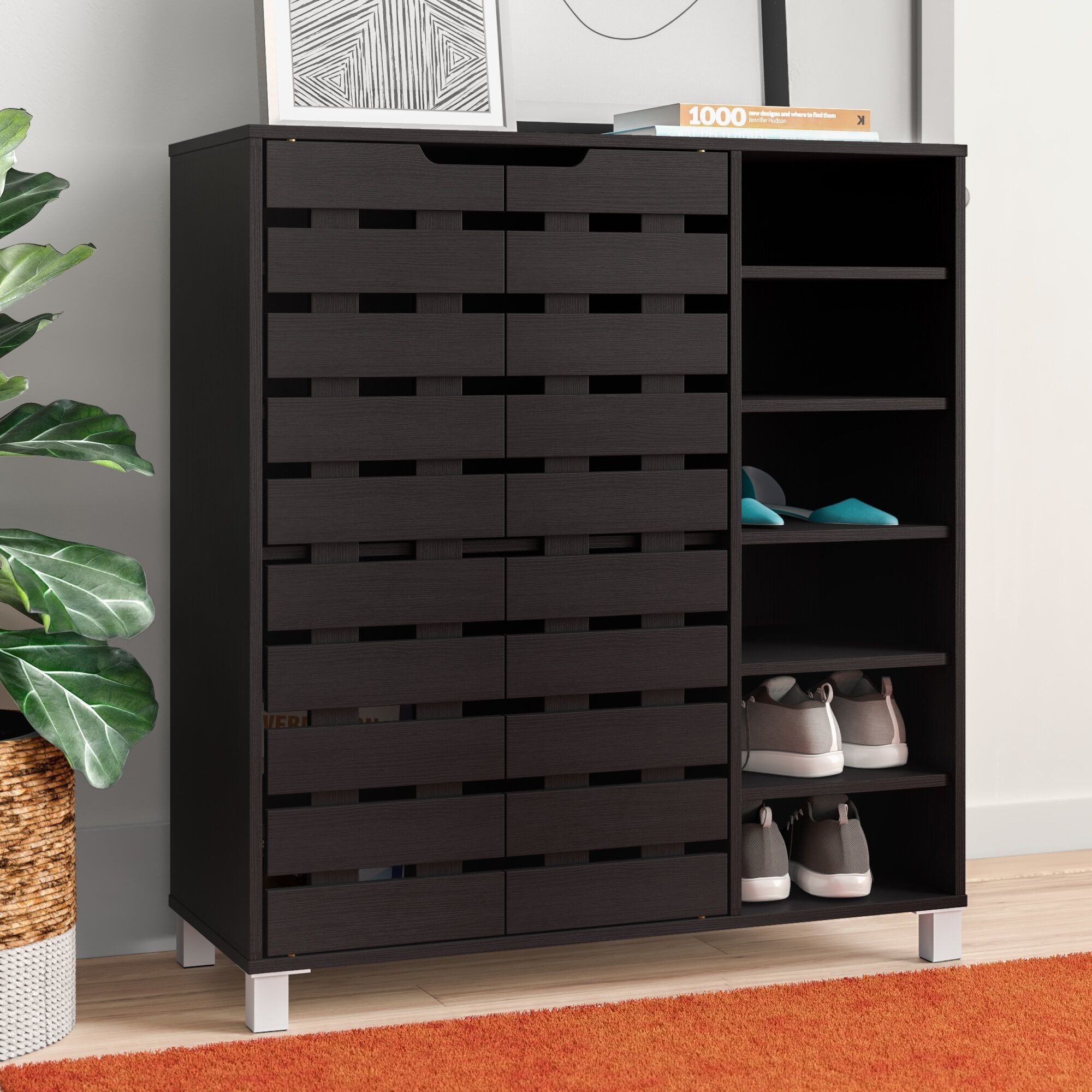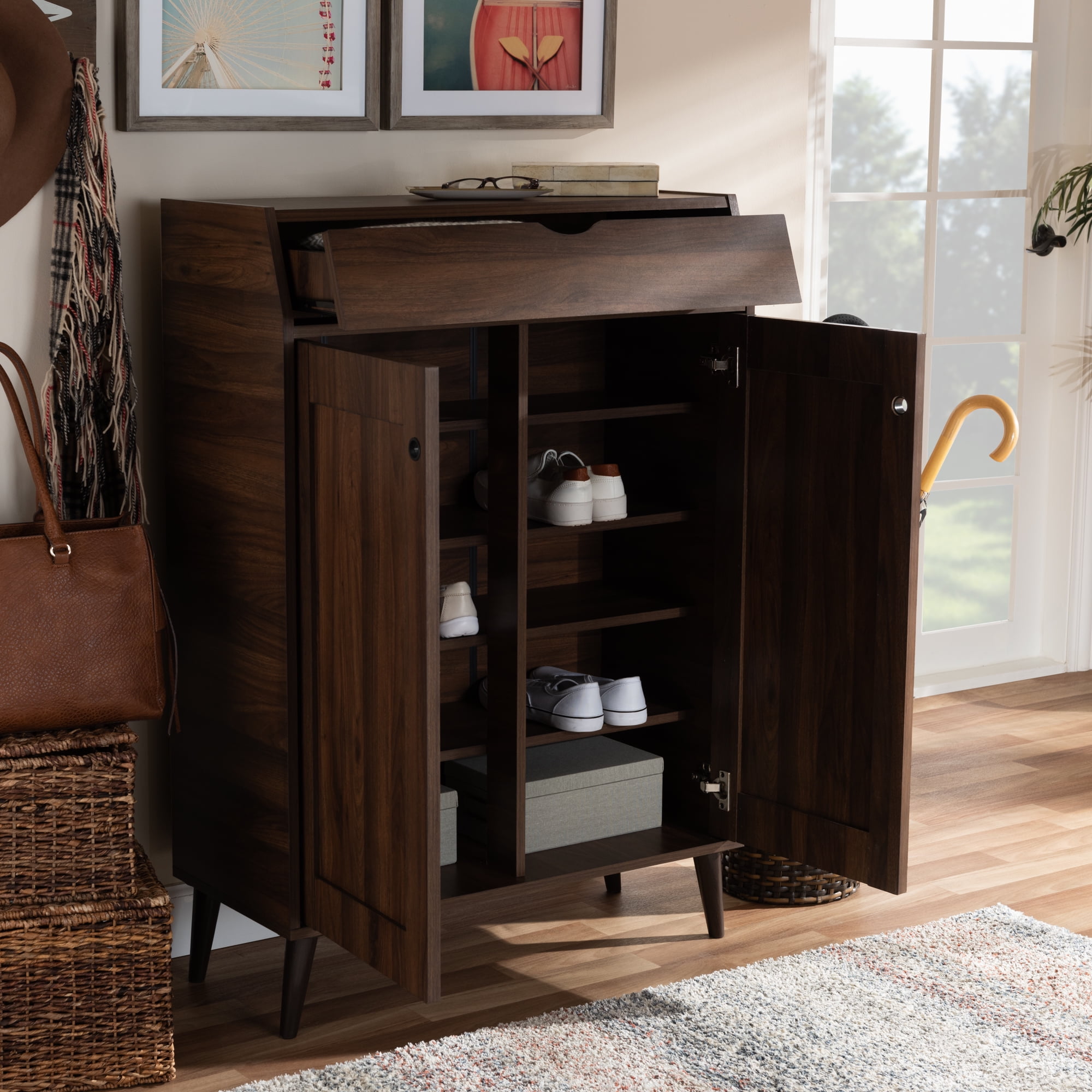Design & Aesthetics of Modern Shoe Cabinets with Doors

Modern shoe cabinets with doors offer a blend of practicality and style, seamlessly integrating storage solutions into contemporary interiors. The design possibilities are vast, encompassing a wide array of materials, finishes, and door styles to suit diverse tastes and home aesthetics. Choosing the right shoe cabinet involves careful consideration of these elements to create a visually appealing and functional addition to your space.
Material, Finish, and Style Variations in Modern Shoe Cabinets
The choice of materials significantly influences the overall aesthetic and durability of a shoe cabinet. Different materials offer unique visual characteristics and contribute to the overall feel of the room. Finishes further enhance the look and feel, impacting the perceived luxury and maintenance requirements.
| Style | Material | Finish | Notable Features |
|---|---|---|---|
| Minimalist | Solid wood (oak, walnut) | Natural, oiled | Clean lines, simple design, emphasis on natural grain |
| Mid-Century Modern | Wood veneer, metal legs | Lacquered, polished | Tapered legs, geometric shapes, subtle detailing |
| Industrial | Metal (steel, iron) | Powder-coated, rusted | Raw, unfinished look, exposed metal elements, often paired with wood |
| Contemporary | High-gloss acrylic, glass | High-gloss, frosted | Sleek, reflective surfaces, modern lines, often incorporates LED lighting |
Impact of Door Styles on Aesthetics and Functionality
The type of door significantly impacts both the visual appeal and practical use of the shoe cabinet. Each style presents unique advantages and disadvantages.
Sliding doors offer space-saving solutions, ideal for smaller entryways or hallways. They provide a sleek, modern aesthetic and can be made from various materials like mirrored glass for a dramatic effect or wood for a warmer feel. Hinged doors, a classic choice, offer full access to the interior and can incorporate interesting design details like ornate handles or unique hinges. Bi-fold doors, a compromise between sliding and hinged doors, allow for easy access while minimizing space requirements. They are a versatile option, suitable for a range of styles from traditional to contemporary.
Visual Impact of Color Schemes and Their Suitability for Different Interior Styles
Color plays a crucial role in setting the mood and tone of a room. A shoe cabinet’s color should complement the existing décor and create a harmonious atmosphere.
A neutral palette, such as off-white, beige, or gray, creates a sense of calm and sophistication. These colors are versatile and work well with various interior styles, from minimalist to traditional. They can also make a small space appear larger. Bold colors, like navy blue, emerald green, or deep red, add a touch of drama and personality. These colors are best suited for rooms with neutral backgrounds to prevent visual overload. They can create a focal point and make a statement. Pastel shades, such as soft pink, lavender, or mint green, evoke a feeling of tranquility and serenity. They work particularly well in bedrooms or children’s rooms. They offer a calming effect and add a touch of femininity or whimsy.
Functionality and Storage Solutions in Modern Shoe Cabinets

Modern shoe cabinets are far more than just storage; they’re integral to maintaining a tidy and stylish home. The functionality and storage solutions offered directly impact the cabinet’s overall effectiveness and user experience. Choosing the right configuration depends heavily on your shoe collection, available space, and personal preferences.
Modern shoe cabinet with doors – Internal organization is key to maximizing a shoe cabinet’s potential. Different storage methods cater to various shoe types and storage needs. Let’s delve into the common options and their relative strengths and weaknesses.
Internal Storage Configurations and Their Effectiveness, Modern shoe cabinet with doors
The choice between shelves, drawers, and compartments significantly impacts how efficiently you can store your shoes. Each configuration has its pros and cons, making certain types more suitable for specific footwear.
- Shelves:
- Pros: Offer a simple, cost-effective solution, suitable for a wide variety of shoes, provide a clear overview of your shoe collection, and are easily adjustable in many designs.
- Cons: Can be less protective for delicate shoes like heels, prone to accumulating dust, and may not be ideal for organizing boots efficiently.
- Drawers:
- Pros: Protect shoes from dust and damage, offer excellent organization for pairs, ideal for delicate shoes or those requiring more protection, and can be stacked vertically to maximize vertical space.
- Cons: Can be more expensive than shelves, may take up more space per shoe than shelves, and accessing shoes at the back of a drawer can be cumbersome.
- Compartments:
- Pros: Allow for precise organization of individual shoes, minimize shifting and potential damage, and are particularly useful for storing a variety of shoe types efficiently.
- Cons: Can be space-inefficient if compartments are too large, require careful planning to accommodate the variety of your shoe collection, and can be more costly than simpler shelf designs.
Enhancing Functionality and Convenience with Added Features
Beyond the basic storage configurations, additional features significantly enhance both the functionality and convenience of a modern shoe cabinet.
- Adjustable Shelves: Allow you to customize the interior space to accommodate different shoe heights and sizes, maximizing space utilization and adapting to changes in your shoe collection over time. For example, you could easily adjust the shelf height to accommodate tall boots during winter and then lower them to make space for sandals in summer.
- Built-in Mirrors: Add a practical and stylish element to the entryway, providing a convenient place to check your appearance before leaving the house. This feature saves space compared to a separate mirror.
- Hidden Compartments: Offer discreet storage for keys, wallets, or other small items, keeping them organized and easily accessible. This is especially beneficial in smaller entryways where space is at a premium.
Innovative Shoe Cabinet Design for Small Entryways
For maximizing space in a small entryway, consider a slim, tall shoe cabinet with a combination of storage solutions.
Design Specifications:
Dimensions: 30cm (W) x 180cm (H) x 20cm (D)
Materials: High-quality, light-colored MDF (Medium-Density Fiberboard) for the cabinet body, providing a clean and modern aesthetic. Durable, easy-to-clean melamine coating for protection and longevity. High-quality metal hinges and drawer slides for smooth operation and durability. Internal shelving and compartments constructed from robust particleboard for load-bearing capacity.
Storage Solution: The lower section would feature two deep drawers for storing bulky items like boots and larger sneakers. The upper section would include adjustable shelves for storing everyday shoes and sandals. A small hidden compartment at the top would be integrated for storing small items like keys and sunglasses. A full-length mirror is incorporated into the cabinet door for added functionality.
Manufacturing and Materials: Modern Shoe Cabinet With Doors
The creation of a modern shoe cabinet, seemingly simple, involves a fascinating interplay of design, material selection, and manufacturing processes. From mass-produced units churned out in factories to bespoke pieces crafted by skilled artisans, the journey from concept to finished product varies significantly, impacting both the final aesthetic and the environmental footprint.
Modern shoe cabinet manufacturing often employs a mix of automated and manual processes. Mass production relies heavily on machinery – Computer Numerical Control (CNC) routers for precise cutting, automated assembly lines for efficient joining, and robotic arms for painting and finishing. This allows for high volume and lower per-unit costs. Handcrafted cabinets, on the other hand, emphasize meticulous attention to detail and personalized customization. Each step, from selecting the wood to applying the final varnish, is performed by skilled hands, resulting in unique pieces with a distinct character.
Manufacturing Processes: Mass Production vs. Handcrafting
Mass-produced shoe cabinets typically follow a streamlined process. Prefabricated components, cut and shaped by CNC machines, are assembled using automated systems. This ensures consistency and speed, making them more affordable. However, this efficiency can sometimes compromise the level of individual customization. In contrast, handcrafted cabinets involve a more artisanal approach. Experienced carpenters select and prepare the wood, carefully shaping and joining each piece. Finishes are often applied by hand, leading to variations that reflect the unique craftsmanship. The process is more time-consuming and labor-intensive, resulting in higher prices but also a greater degree of personalization and a more tangible connection to the maker’s skill.
Mass production prioritizes efficiency and affordability, while handcrafting emphasizes uniqueness and the artisan’s skill.
Material Sustainability and Environmental Impact
The environmental impact of a shoe cabinet is largely determined by the materials used in its construction. Sustainably sourced wood, certified by organizations like the Forest Stewardship Council (FSC), is a responsible choice, ensuring that the timber comes from forests managed for long-term health. Recycled materials, such as reclaimed wood or recycled metal, significantly reduce the demand for new resources and minimize waste. However, even these sustainable options have an environmental cost associated with transportation and manufacturing.
Choosing sustainably sourced wood and recycled materials minimizes the environmental impact of shoe cabinet production.
Using engineered wood products, like Medium-Density Fiberboard (MDF) or plywood, can also be a more sustainable option compared to using solid wood from unsustainable sources. These materials often use smaller pieces of wood or recycled wood fibers, reducing the demand for whole trees. However, it’s crucial to consider the manufacturing processes and the adhesives used in these products, as some may contain volatile organic compounds (VOCs) that can affect indoor air quality. The use of low-VOC adhesives and finishes is vital for a truly environmentally friendly approach. Finally, the durability of the chosen materials plays a significant role in the overall sustainability. A longer-lasting cabinet reduces the need for frequent replacements, minimizing waste and resource consumption over its lifespan.
